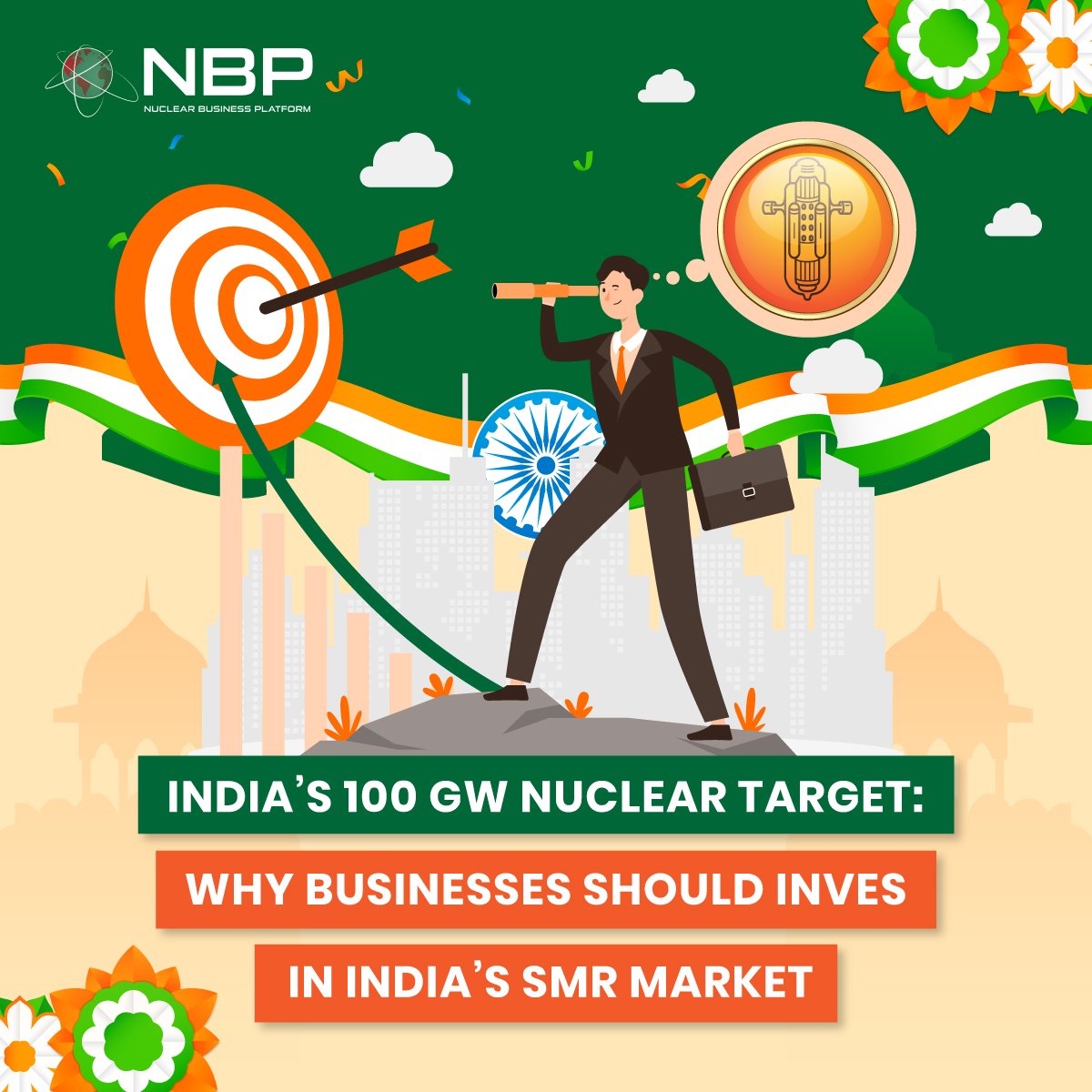India’s 100 GW Nuclear Target: Why Businesses Should Invest in India’s SMR Market
India’s nuclear energy sector is undergoing a major transformation, with Small Modular Reactors (SMRs) poised to play a pivotal role in the country’s energy transition. The Union Budget 2025 has earmarked Rs. 20,000 crore for SMR research and development under the Nuclear Energy Mission, setting the stage for increased investment and industry participation. The introduction of Bharat Small Modular Reactors (BSMRs) and strengthened collaborations between the Nuclear Power Corporation of India Limited (NPCIL) and potential private enterprises will be instrumental in shaping a competitive SMR market. This shift presents significant business opportunities in clean, scalable, and commercially viable nuclear energy solutions.
Why India’s SMR Market Offers a Lucrative Investment Opportunity
India’s ambition to achieve 100 GW of nuclear power capacity by 2047 opens up a multi-billion-dollar market for investors, energy firms, and industrial players. Unlike traditional large-scale reactors, SMRs—particularly Bharat Small Modular Reactors (BSMRs)—offer a factory-built, modular, and rapidly deployable solution aligned with global trends in nuclear energy.
Additionally, Bharat Small Reactors (BSRs), smaller versions of India’s existing 220 MW Pressurized Heavy Water Reactors (PHWRs), present an immediate opportunity for industrial power generation. While BSRs utilize proven technology to deliver stable, large-scale, low-carbon power for industries, BSMRs represent a future-focused investment in advanced, factory-fabricated, and globally competitive nuclear solutions.
Strategic Business Advantages in India’s SMR Expansion
1. Direct Business Gains for Energy-Intensive Industries
SMRs provide a stable, long-term energy solution as India intensifies its decarbonization efforts. Energy-intensive industries, including steel, aluminum, and cement manufacturing, can leverage SMRs to reduce their dependence on fossil fuels while ensuring an uninterrupted power supply. Early adopters of SMR-based power generation stand to gain regulatory advantages, tax benefits, and long-term cost efficiencies.
2. Public-Private Partnerships: A Risk-Sharing Investment Model
NPCIL’s evolving business strategy embraces a hybrid investment model where private enterprises contribute land, cooling water, and financial capital, while NPCIL manages reactor safety, design, and operations. This approach minimizes regulatory complexities for private investors while enabling broader participation in India’s nuclear energy sector. Companies investing in SMR-related infrastructure today will secure long-term contracts in India’s evolving energy landscape.
3. Infrastructure Optimization & Captive Industrial Power
SMRs require significantly less land, cooling water, and exclusion zone compared to traditional nuclear plants, making them an ideal solution for industries with space constraints or localized power needs. The reduced exclusion zone allows SMRs to be sited closer to industrial hubs, optimizing land use and lowering infrastructure costs. By adopting a distributed energy model, industries can establish captive SMR-based power plants, reducing reliance on grid-based electricity and minimizing transmission losses. Companies investing in on-site SMRs can secure long-term energy stability and pricing predictability.
4. Technological Partnerships & Global Market Access
India’s SMR initiative has already attracted international interest, with firms like Rosatom exploring collaboration opportunities. Planned amendments to the Atomic Energy Act and Civil Liability for Nuclear Damage Act will enable broader private-sector participation, opening new avenues for domestic and foreign investment. Leading Indian energy firms, such as Tata Power, are already considering entry into the SMR market as part of their clean energy strategy. As regulatory frameworks evolve, technology providers, infrastructure developers, and venture capital firms have an unprecedented opportunity to shape India’s nuclear industry.
Overcoming Challenges: Business Strategies for Maximizing Returns
1. Gaining First-Mover Advantage in Regulatory Evolution
India’s nuclear sector remains highly regulated, but upcoming amendments to liability laws could unlock new investment opportunities. Businesses that actively engage in policy discussions and adapt to regulatory changes will position themselves ahead of competitors, securing early contracts in an emerging market.
2. Ensuring Cost Competitiveness & Financial Structuring
While nuclear power currently costs between ₹4-4.1 per kWh—compared to ₹1.5-2 per kWh for coal-based energy—SMRs present a long-term economic advantage through modular construction and mass production. Investors leveraging power purchase agreements (PPAs), government-backed financing, and tax incentives can significantly enhance the financial viability of SMRs. Infrastructure investors seeking stable, government-supported returns will find SMRs a highly attractive asset class.
3. Strengthening the Domestic Supply Chain for Market Leadership
Scaling SMR production in India requires strategic investments in nuclear-grade manufacturing, local component supply chains, and skilled workforce development. Engineering firms, advanced manufacturing companies, and technology providers entering the market early will play a dominant role in shaping India’s SMR ecosystem.
The Investment Case: Why Businesses Should Act Now
With the Indian government planning to operationalize five SMRs by 2033, the ₹20,000 crore investment signals a long-term commitment to nuclear energy expansion. Businesses that align with this initiative today will benefit from:
Early-mover advantage in a sector opening up to private participation.
Guaranteed energy security through SMR-based captive power solutions for industrial operations.
Government-backed incentives for nuclear infrastructure and clean energy projects.
New revenue streams for technology providers, supply chain developers, and infrastructure firms.
A role in India’s global SMR exports, leveraging its cost-efficient nuclear technology base.
As the world shifts toward sustainable and decentralized energy solutions, India’s SMR program presents an unparalleled business opportunity. Companies investing in this nuclear revolution now will shape the future of clean energy, secure long-term financial returns, and establish themselves as leaders in India’s growing nuclear economy. One key opportunity for businesses looking to enter India’s nuclear sector will be India Nuclear Business Platform (INBP) 2025—a premier industry event that connects policymakers, global stakeholders, and business leaders. Engaging at INBP 2025 will provide companies with critical networking opportunities, investment insights, and strategic partnerships, positioning them at the forefront of India’s nuclear expansion.



